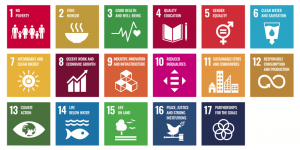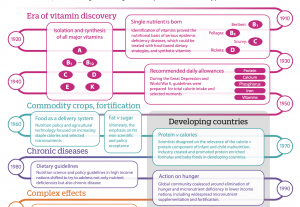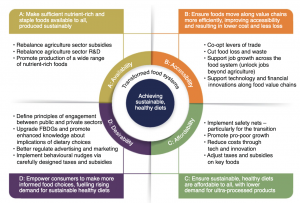Dariush Mozaffarian, is a cardiologist and public health expert whose work at Tufts University (Boston, USA) focuses prominently on science-based food and nutrition policies aiming to tackle obesity, diabetes and cardiovascular disease in the US and globally. Dr. Mozaffarian, introduced us to how food systems should look in the 21st century to be able to tackle our current and future challenges, during the Transforming Food Systems session at the American Society for Nutrition (ASN) conference: Nutrition Live Online 2021.
Mapping sustainability for food systems
In the midst of the second year of the COVID crisis, we cannot deny that this is not the only pandemic we are dealing with nowadays. The current global dietary patterns pose a massive risk for developing chronic diseases such as obesity, cardiovascular disease and diabetes. These dietary patterns are thus the source of many of the major causes for death and morbidity worldwide but they are also a key factor in sustainability.

The Sustainable Development Goals (SDGs), proposed by the United Nations in 2015 comprise 17 comprehensive goals set to be met by 2030. Unfortunately, many of these goals are not going to be achieved due to what is still NOT changing with our existing food systems. When it comes to the role of food and nutrition on these goals, the biggest focus is placed on ending hunger (SDG 2) and climate action (SDG 13). Indeed, lack of access to healthy and nutritious food is still a very serious issue in many parts of the world, and 25% of all climate emissions are due to the agricultural and food production sector. But we often forget that food and nutrition can have a direct impact on our overall health and well-being (SDG 3) and not enough focus is being placed on this, which is a “big missing link” as Dr. Mozaffarian called it, since “to think about food systems is really to think about chronic diseases”.
Additionally, food waste is also a problem not being sufficiently addressed in relation to responsible consumption and production (SDG 12) since our current food systems are contributing greatly to the loss of biodiversity and deforestation. This tendency for overproduction and overconsumption has also placed a great stress on our oceans, affecting the balance and ecosystems below water (SDG 14), which in turn might also affect our access to clean water and sanitation (SDG 6) because most of our water is being used towards agriculture. Food-related businesses have been the most direct way out of poverty (SDG 1) for many communities, whether this is on the production, distribution, or hospitality sectors, which is also an important sector when we want to guarantee a reduction in inequalities and disparities (SDG 10).
So, in order to have more sustainable agricultural practices and food systems we also need to think creating new routes in terms of innovation and infrastructure (SDG 9), one of the biggest challenges for the future will rely heavily in the reinvention of industries to produce food that is both nutritious, sustainable and profitable.
As we can see, food and nutrition are very closely intertwined with many of the 17 SDGs. Thus, in order to design the food systems of the future we cannot keep thinking of food as an isolated item. We need to create food-related policies that consider all the complex ramifications that the food production chain has on the SDGs, on our health, and on the global burden of disease and mortality.
So, what are the new bold innovative actions in food systems that will allow us to meet the SDGs by 2030? And what are the pieces missing to get us there?
Paving the way to the food systems of the future
Dr. Mozaffarian remarks that “to know where we want to go, we need to understand how we got here”, so to create future solutions, we need to look at how we got to our current food system.

Our modern food system is a reflection of the legacy of the goals of the 20th century, which was shaped by two major events. First, the discovery of all the vitamins and their roles in disease development. For the first time it was discovered that a single nutrient could be the sole cause (and cure) for a disease, which of course lead into initiatives that focused of fortification. Second, the population explosion which translated into the fear of mass starvation. This is how the so-called Green Revolution came to be, prompting the mass production of starchy foods that could feed the increasing population. As a result, we have a 20th century food system that relies on heavily processed foods which are stable for transportation, which are energy-dense to fend off starvation, meaning rich in starch, fat and sugar, and which are fortified with vitamins to avoid single-nutrient diseases. In summary, food designed to ‘treat’ caloric insufficiency and vitamin deficiency.

What we did not realize then, is that these ‘cures’ would lead to more serious chronic problems down the line. Chronic diseases are disabling and killing our population worldwide with conditions including diabetes, heart disease, obesity, cancer, and many others. So now we need to switch into a food system fitted to the needs of the 21st century, focusing on nutrition equity and sustainability instead. This can be achieved through the four pillars described by Patrick Webb (who was the chair of the session on Transforming Food Systems at ASN’s Live Online 2021 Conference). First, we need to ensure that sufficient nutritious food is available to all and that it has been produced in a sustainable way. Second, we need to improve accessibility by finding ways to move along value chains in a more efficient manner, which can then result in lower costs and less food waste. Third, we need to make sure that healthier diets are affordable, lowering the demand for ultra-processed foods. And fourth, empower the consumers to make informed food choices by increasing the desirability of healthier diets.
The road ahead…
So, how can we design food systems that will meet the UN’s SDGs by 2030? What are the missing pieces? According to Dr. Mozaffarian, “we are not going to solve the problems of today with the solutions of yesterday”. So first and foremost, we need to find and create new solutions, and to do so we need to invest in science, research and innovation. We need to make huge global investments in both public and private science so that we can expand and improve every field from agriculture and food production to behavior change and everything in between. Then, we need to be able to renovate our current food environments to make them better suited for healthier diets, in particular, we need to transform those places where people buy and eat their food. We also need to emphasize the importance of diet-related chronic diseases, we need to make space to address the increasing amount of people suffering from obesity, cardiovascular disease, diabetes, cancer, and other chronic diseases that are highly linked to overnutrition.
It is also paramount to re-invent agriculture. New agricultural practices need to focus not only on the production of nutrient-rich and minimally processed foods that can be transported around the world at an effective cost, but also on new ways to mitigate the climate crisis by reducing the impact that our current practices have on the environment. If we are to reach the SDGs, we need to engage the private sector as well as the public, every stakeholder from farming to retail and hospitality industries needs a seat at the table to become part of the solution and not the problem. And lastly, we need to establish true cost accounting; so far we have only focused on how much it costs to produce food and how much it costs to buy it, but moving forward we need to account for additional costs such as healthcare costs, loss of productivity, climate and environmental costs, etc. and here is where governments can play a crucial role in designing and implementing policies that ensure that those economic tradeoffs are accounted in the market.
To be able to move onto a food system designed for the 21st century, we have to push forward the nutrition science, agricultural science and behavioral science and continue to explore emerging fields (including gut microbiome, personalized nutrition, phenolics and flavonols, food processing, additives, timing of meals or chrono-nutrition, brain health, immunity, allergies, etc.). More importantly, science has to intercept with policy, otherwise this is all stale knowledge. Dr. Mozaffarian remains optimistic that through advancing and promoting science and using science-based nutrition policies we can unite scientists, governments, and the private sector, so that we can transform our food systems to meet our current and future needs together.
Read more:
UN’s Sustainable Development Goals (https://sdgs.un.org/goals)
History of modern nutrition science—implications for current research, dietary guidelines, and food policy. D. Mozaffarian et al. 2018, BMJ (https://doi.org/10.1136/bmj.k2392)
The urgency of food system transformation is now irrefutable. P. Webb et al. 2020 Nature Food (https://doi.org/10.1038/s43016-020-00161-0)
Transforming Food Systems: The Missing Pieces Needed to Make Them Work. E. Kennedy et al. 2021, Current Developments in Nutrition (https://doi.org/10.1093/cdn/nzaa177)

